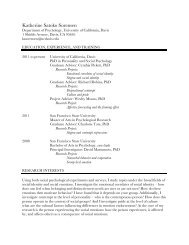The Psychology of Creativity:
The Psychology of Creativity:
The Psychology of Creativity:
You also want an ePaper? Increase the reach of your titles
YUMPU automatically turns print PDFs into web optimized ePapers that Google loves.
History <strong>of</strong> <strong>Creativity</strong> Research 10<br />
been echoed many times since, from Seneca’s (n.d./1932) “no great genius has ever existed without some touch <strong>of</strong><br />
madness” (p. 285) to Shakespeare’s “<strong>The</strong> lunatic, the lover, and the poet/ Are <strong>of</strong> imagination all compact” (quoted in<br />
Browning, 1986, p. 77). Two events enhanced the popularity <strong>of</strong> this mad-genius hypothesis. <strong>The</strong> first was the<br />
advent <strong>of</strong> the Romantic movement at the end <strong>of</strong> the 17th century and the beginning <strong>of</strong> the 18th. <strong>The</strong> Romantics<br />
exalted creative genius, giving it something <strong>of</strong> the mystery it had lost. However, rather than return to the religious<br />
or spiritual conception <strong>of</strong> creativity, the Romantics viewed it in more psychopathological terms. This conception is<br />
most conspicuous in the place that psychoactive drugs had in creative inspiration. For instance, Coleridge’s Preface<br />
to “Kubla Khan” claimed that he conceived this poetic masterpiece in an opium stupor. Yet the evidence from<br />
surviving manuscripts indicate quite the contrary (Schneider, 1953). Coleridge presumably distorted the poem’s<br />
origins because it would enhance its stature as a creative product, not detract from its apparent merits.<br />
Almost simultaneous with the Romantic movement was a second, totally unrelated event: Philippe Pinel<br />
initiated a total reform <strong>of</strong> French mental institutions. This reform affected not just therapeutic techniques but the<br />
theory <strong>of</strong> mental disease besides. Rather than being perceived as a form <strong>of</strong> demonic possession, mental illness<br />
would become attributed to naturalistic causes, whether biological or psychological. During the course <strong>of</strong> the 19th<br />
century, psychiatry would develop as a formal discipline, following upon the footsteps <strong>of</strong> such French pioneers as<br />
Jean Martin Charcot and Pierre Janet. Psychiatry combined an interest in the abnormal mind with expertise in<br />
neurology, including pathologies <strong>of</strong> the nervous system. Increasingly, certain neurological disorders were lined with<br />
both positive outcomes, like genius, and negative outcomes, like crime. For example, the Italian criminologist<br />
Cesare Lombroso (1891) proposed in his <strong>The</strong> Man <strong>of</strong> Genius exceptional achievement was based on a “degenerative<br />
psychosis” <strong>of</strong> the “epileptic group.” Because nervous pathologies were <strong>of</strong>ten ascribed to genetic deficiencies,<br />
madness and genius would sometimes be seen as having a common genetic foundation. Thus, an article published<br />
in the reputable Journal <strong>of</strong> Nervous and Mental Disease listed the four possible repercussions <strong>of</strong> a single congenital<br />
defect:<br />
First, and most prominent in the order <strong>of</strong> frequency is an early death. Second, he may help swell the<br />
criminal ranks. Third, he may become mentally deranged and ultimately find his way into a hospital for the<br />
insane. Fourth, and least frequently, he startles the world by an invention or discovery in science or by an<br />
original composition <strong>of</strong> great merit in art, music or literature. He is then styled a genius. (Babcock, 1895,<br />
p. 752)
















